From Zygote to Newborn
germinal period
The first two weeks of development after conception, characterized by rapid cell division and the beginning of cell differentiation.
embryonic period
The stage of prenatal development from the end of the second week through the eighth week after conception, during which the basic forms of body structures, including internal organs but not sex organs, develop.
fetal period
The stage of prenatal development from the ninth week after conception until birth, during which the fetus grows in size and matures in functioning.
Prenatal development is often divided into three main periods: The first two weeks are the germinal period; the third through the eighth week is the embryonic period; the ninth week until birth is the fetal period (see Table 2.2 for alternative terms).
Popular and professional books use various words to segment pregnancy. The following comments help to clarify the terms used.
|
Germinal: The First 14 Days
Within hours after conception, the zygote begins duplication and division. First, the 23 pairs of chromosomes duplicate, forming two complete sets of the genome. The cell divides neatly down the middle into two cells, each containing the original genetic code. These two new cells duplicate and divide, becoming four, which duplicate and divide, becoming eight, and so on.
stem cells
Cells from which any other specialized type of cell can form.
Those first cells are stem cells, able to produce every other cell and thus become a complete person. If conception occurs in vitro, in a laboratory, one stem cell could be removed and analyzed (for instance, if both parents are carriers of a serious disease). If no abnormality is found, the other cells are implanted, to become a normal, complete human being.
After about the eight-
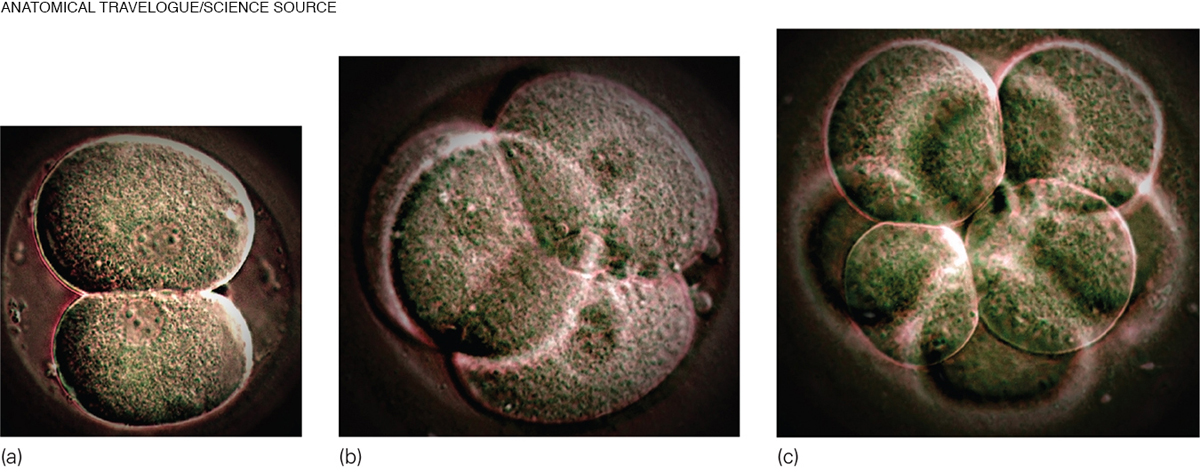
Differentiation means that some cells become part of an eye, others part of a finger, still others part of the brain. About a week after conception, the multiplying cells (now numbering more than 100) separate into two distinct masses.
The outer cells form a shell that will become the placenta (the organ that surrounds and protects the developing creature), and the inner cells form a nucleus that will, in a few more days, become the embryo. The placenta grows first, because it must convey nourishment, enabling the embryo to grow.
implantation
The process, beginning about 10 days after conception, in which the developing organism burrows into the tissue that lines the uterus, where it will be nourished.
The first task of those outer cells is implantation—that is, to embed themselves in the lining of the uterus. This is far from automatic; about 50 percent of natural conceptions and an even larger percentage of in vitro conceptions never implant (see Table 2.3). Most new life ends before an embryo begins (Sadler, 2015).
|
The Germinal Period An estimated 60 percent of all zygotes do not grow or implant properly and thus do not survive the germinal period. Many of these organisms are abnormal; few women realize they were pregnant. The Embryonic Period About 20 percent of all embryos are aborted spontaneously. This is usually called an early miscarriage, a term that implies something wrong with the woman, when in fact the most common reason for a spontaneous abortion is a chromosomal abnormality. The Fetal Period About 5 percent of all fetuses are aborted spontaneously before viability at 22 weeks or are stillborn, defined as born dead after 22 weeks. This is much more common in poor nations. Birth Because of all these factors, only about 31 percent of all zygotes grow and survive to become living newborn babies. Age of the mother is crucial. One estimate is that less than 3 percent of all conceptions after age 40 result in live births. |
Data from Bentley & Mascie-
Embryo: From the Third Through the Eighth Week
embryo
The name for a developing human organism from two to eight weeks after conception.
The start of the third week after conception initiates the embryonic period, during which the formless mass of cells takes shape and merits a new name, embryo.
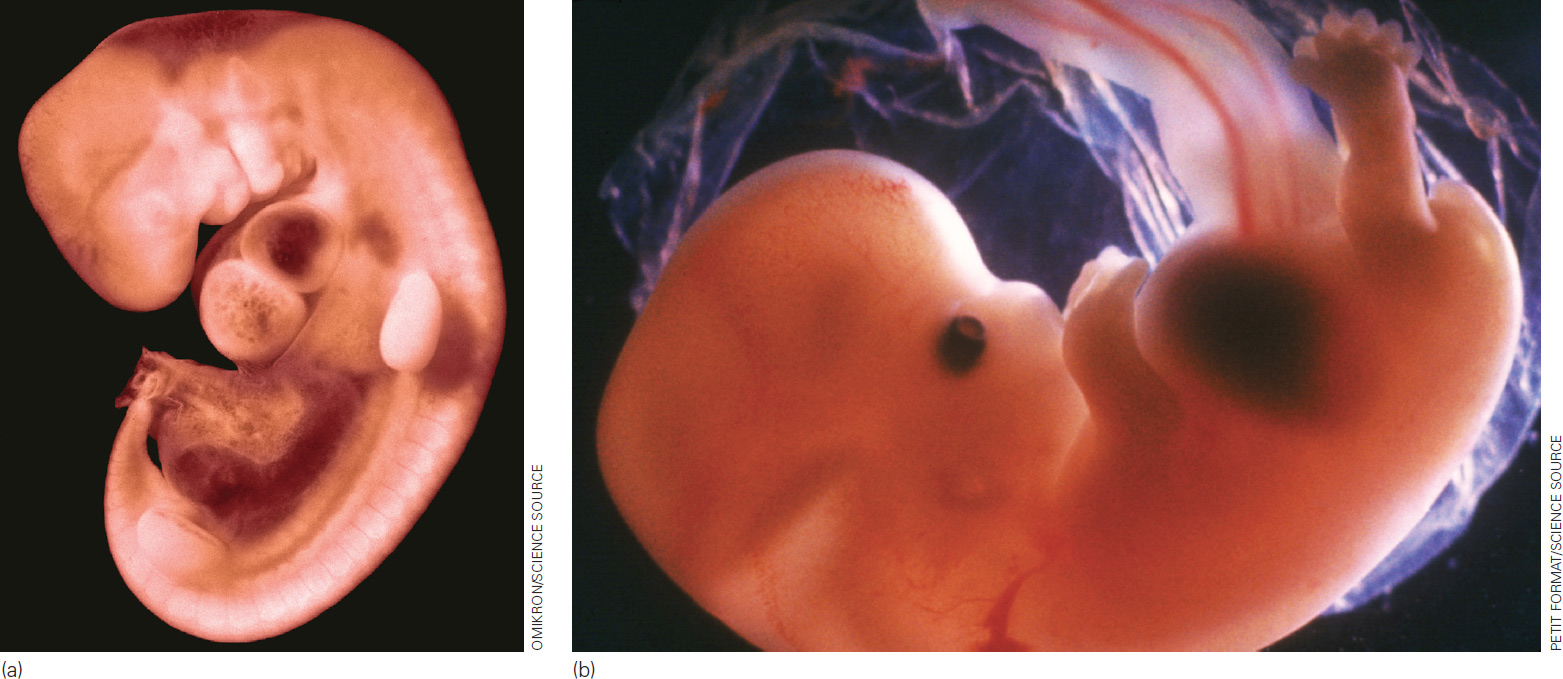
The embryonic period begins when a thin line (called the primitive streak) appears down the middle of the cell mass. That line becomes the neural tube, eventually becoming the central nervous system, including the brain and spine (Sadler, 2015). The head appears in the fourth week, as eyes, ears, nose, and mouth start to form. Also in the fourth week, a minuscule blood vessel that will become the heart begins to pulsate.
By the fifth week, buds that will become arms and legs emerge. The upper arms and then forearms, palms, and webbed fingers grow. Legs, knees, feet, and webbed toes, in that order, are apparent a few days later. Then, 52 and 54 days after conception, respectively, the fingers and toes separate (Sadler, 2015).
At the end of the eighth week after conception (56 days), the embryo weighs just one-
Fetus: From the Ninth Week Until Birth
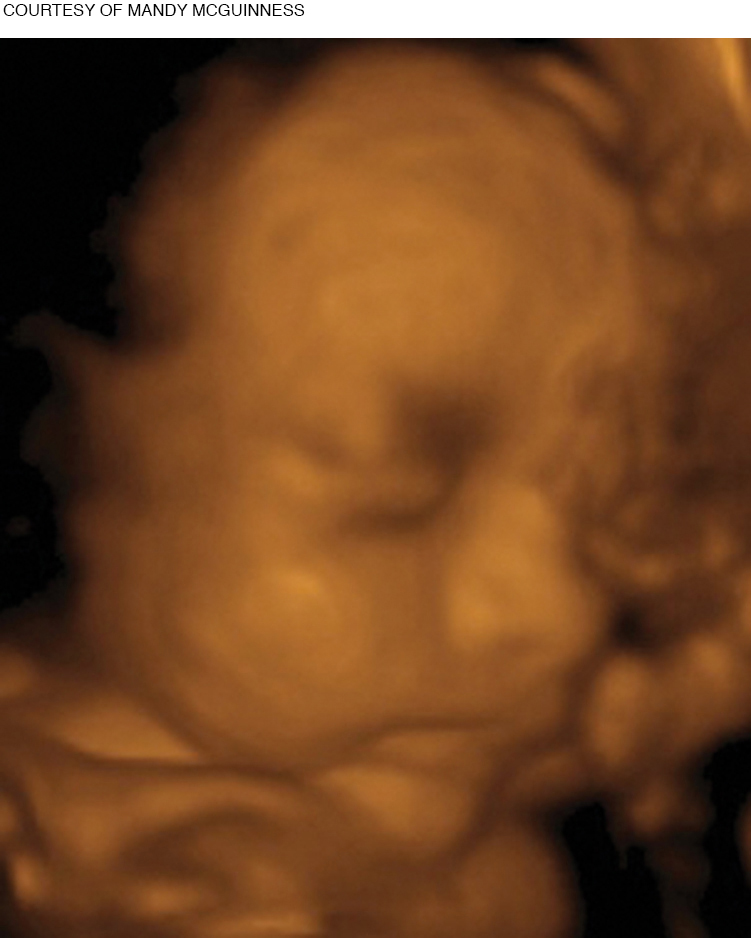
Video: Prenatal Period: 3D Ultrasound shows a real-
The fetal period encompasses dramatic change, from a tiny, sexless creature smaller than the final joint of your thumb to a boy or girl about 20 inches (51 centimeters) long.
sonogram
An image of a fetus (or an internal organ) produced by using high-
fetus
The name for a developing human organism from the start of the ninth week after conception until birth.
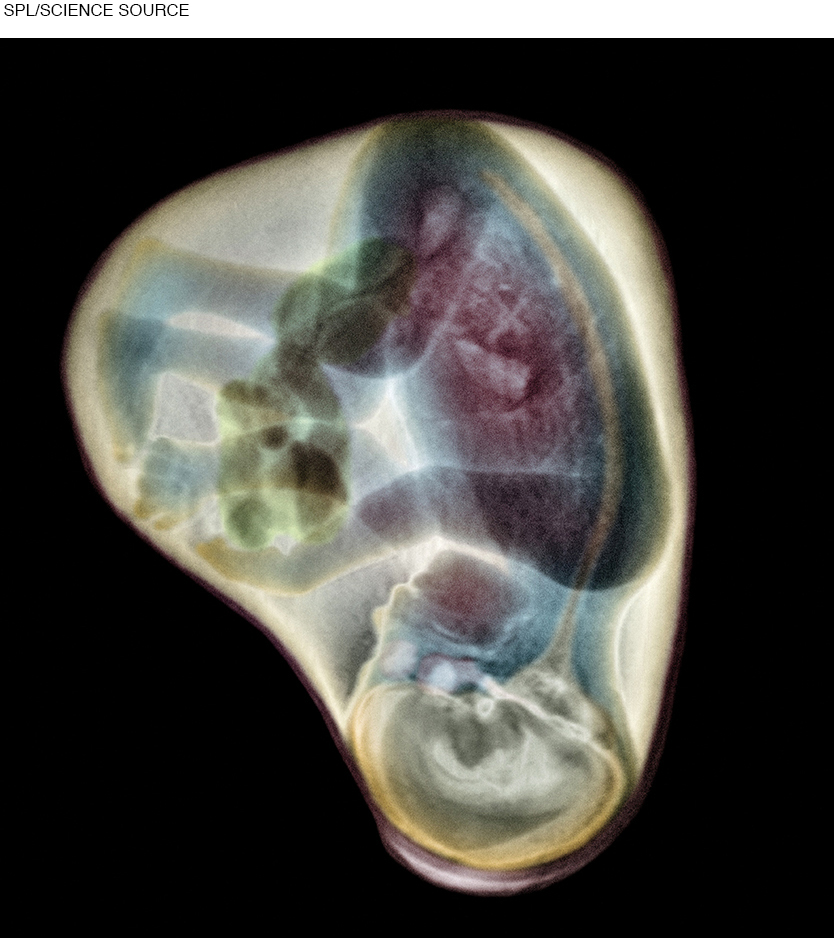
In the ninth week, sex organs develop, soon visible via a sonogram (also called ultrasound). The male fetus experiences a rush of the hormone testosterone, affecting the brain (Lombardo et al., 2012).
By 3 months, the fetus weighs about 3 ounces (87 grams) and is about 3 inches (7.5 centimeters) long. Those numbers—
Mid-
age of viability
The age (about 22 weeks after conception) at which a fetus may survive outside the mother’s uterus if specialized medical care is available.
The entire central nervous system begins to regulate basic body functions such as breathing and sucking (Johnson, 2011). Advances in neurological functioning at the end of this trimester allow the fetus to reach the age of viability, the time past gestation when a fetus born far too early can become a baby who is able to survive.
Thanks to intensive medical care, the age of viability decreased dramatically in the twentieth century, but it now seems stuck at about 22 weeks after conception because even the most advanced technology cannot maintain life without some brain response (see Figure 2.4).
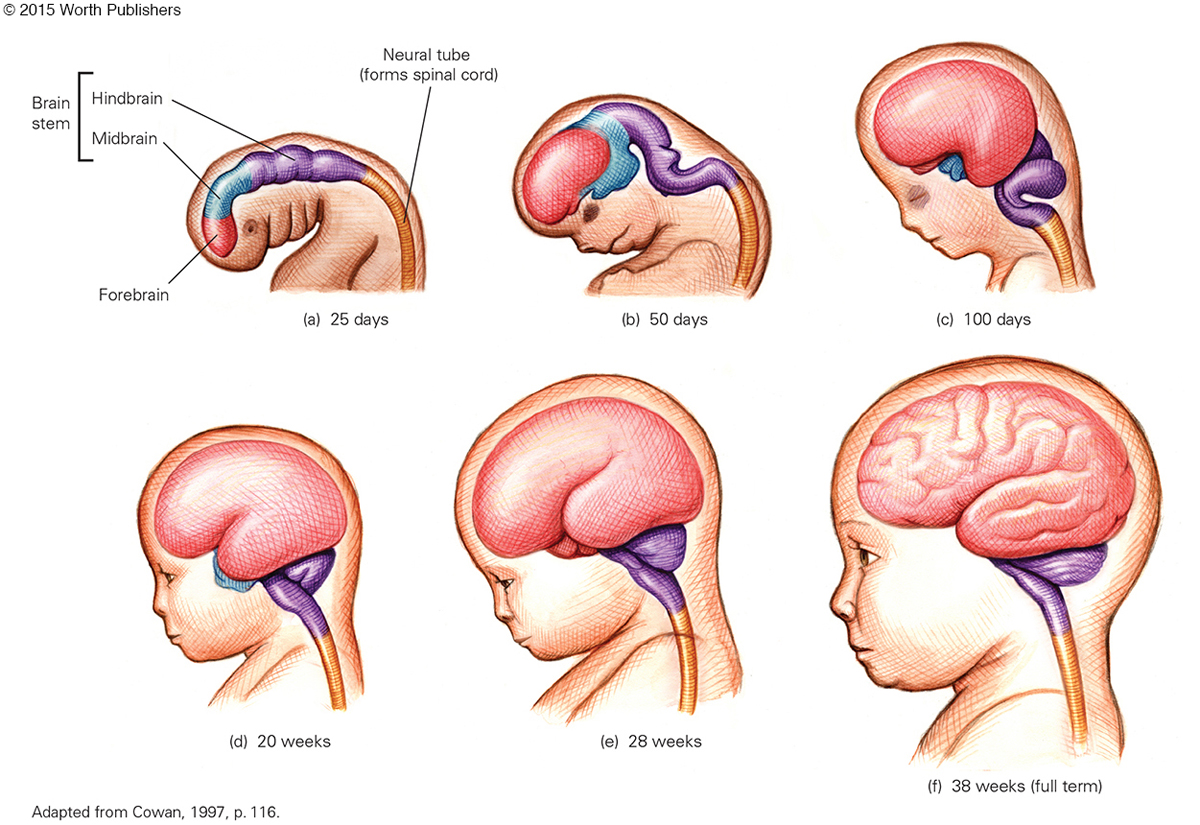
Video: Brain Development Animation: Prenatal
Attaining the age of viability simply means that life outside the womb is possible. Whether or not a non-
Usually, by nine months or so, newborns are ready to thrive at home on mother’s milk—
Finally, a Baby
About 38 weeks (266 days) after conception, the fetal brain signals the release of hormones to start labor. The average baby is born after about 12 hours of active labor for first births and 7 hours for subsequent births, although labor may take twice or half as long. The definition of “active” labor varies, which is one reason some women believe they are in active labor for days and others say 10 minutes.
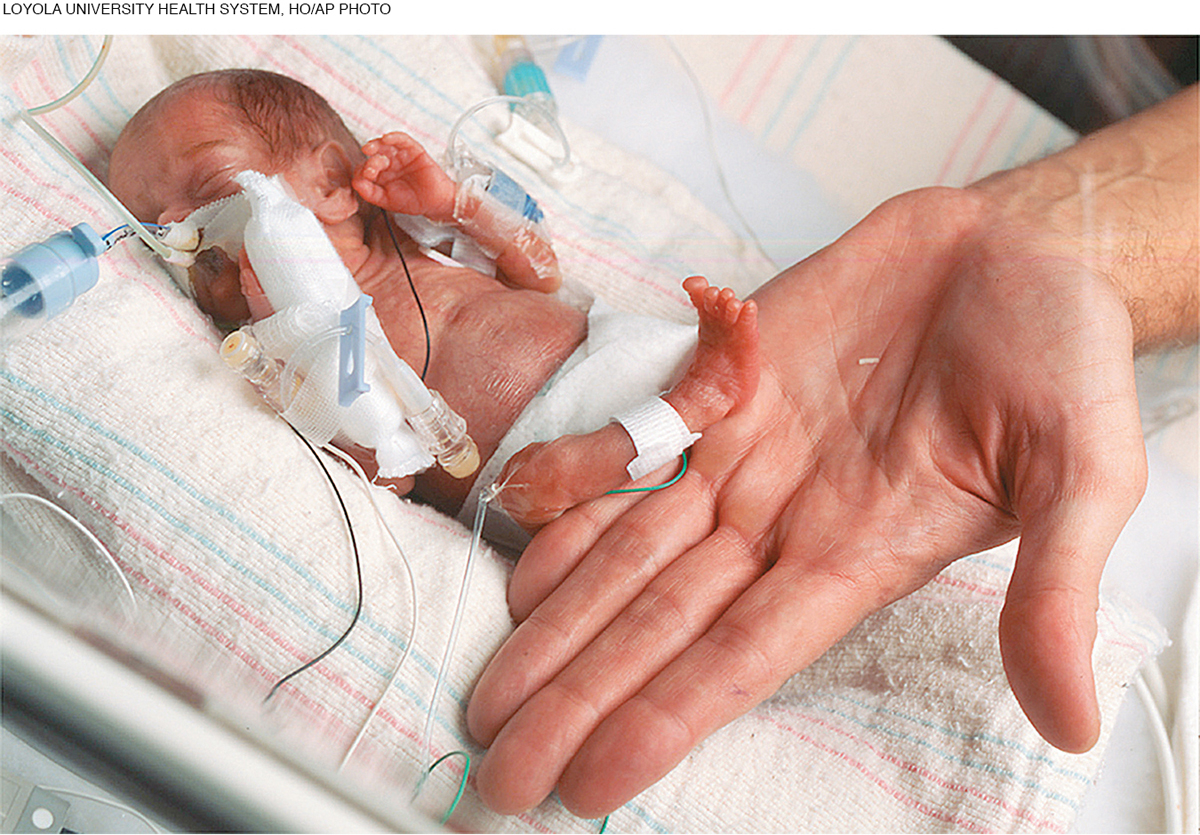
Women’s birthing positions vary—
| Period of Development | Weeks Past Conception | Average Weight (nonmetric) | Average Weight (metric) | Notes |
| End of embryonic period | 8 | 1/30 oz | 1 g | Most common time for spontaneous abortion (miscarriage). |
| End of first trimester | 13 | 3 oz | 85 g | |
| At viability (50/50 chance of survival) | 22– |
20– |
565– |
A birthweight of less than 2 lb, 3 oz (1,000 g) is extremely low birthweight (ELBW). |
| End of second trimester | 26– |
2– |
900– |
Less than 3 lb, 5 oz (1,500 g) is very low birthweight (VLBW). |
| End of preterm period | 35 | 5½ lb | 2,500 g | Less than 5½ lb (2,500 g) is low birthweight (LBW). |
| Full term | 38 | 7½ lb | 3,400 g | Between 5½ lb and 9 lb (2,500– |
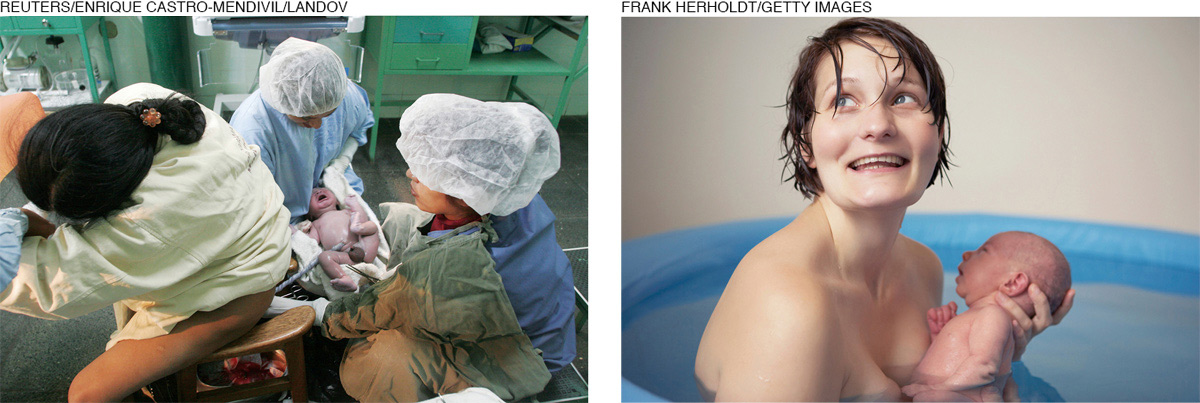
Preferences and opinions on birthing positions (as on almost every other aspect of prenatal development and birth) are partly cultural and partly personal. In general, physicians find it easier to see the head emerge if the woman lies on her back. However, many women find it easier to push the fetus out if they sit up. (Figure 2.5 shows the stages of birth.)

THE NEWBORN’S FIRST MINUTES Newborns usually breathe and cry on their own. Between spontaneous cries, the first breaths of air bring oxygen to the lungs and blood, and the infant’s color changes from bluish to pinkish. (Pinkish refers to blood color, visible beneath the skin, and applies to newborns of all hues.) Eyes open wide; tiny fingers grab; even tinier toes stretch and retract. The full-
Apgar scale
A quick assessment of a newborn’s body functioning. The baby’s heart rate, respiratory effort, muscle tone, color, and reflexes are given a score of 0, 1, or 2 twice—
One assessment of newborn health is the Apgar scale, first developed by Dr. Virginia Apgar. When she earned her MD in 1933, Apgar wanted to work in a hospital but was told that only men did surgery. Consequently, she became an anesthesiologist.
Apgar saw that “delivery room doctors focused on mothers and paid little attention to babies. Those who were small and struggling were often left to die” (Beck, 2009, p. D1). To save those young lives, Apgar developed a simple rating scale of five vital signs—
Since 1950, birth attendants worldwide have used the Apgar (often using the name as an acronym: Appearance, Pulse, Grimace, Activity, and Respiration) at one minute and again at five minutes after birth, assigning each vital sign a score of 0, 1, or 2. If the five-
MEDICAL ASSISTANCE AT BIRTH The specifics of birth depend on many factors, including the position and size of the fetus, the skill of the birth attendant, and the customs of the culture. In developed nations, births almost always include sterile procedures, electronic monitoring, and drugs to dull pain or speed contractions. A recent U.S. study found that 87 percent of hospital births are free of any complications (Glance et al., 2014).
cesarean section (c-
A surgical birth, in which incisions through the mother’s abdomen and uterus allow the fetus to be removed quickly, instead of being delivered through the vagina.
Midwives are as skilled at delivering babies as physicians are, but in most nations only medical doctors perform surgery. More than one-
The World Health Organization suggests that cesareans are medically indicated in 10–

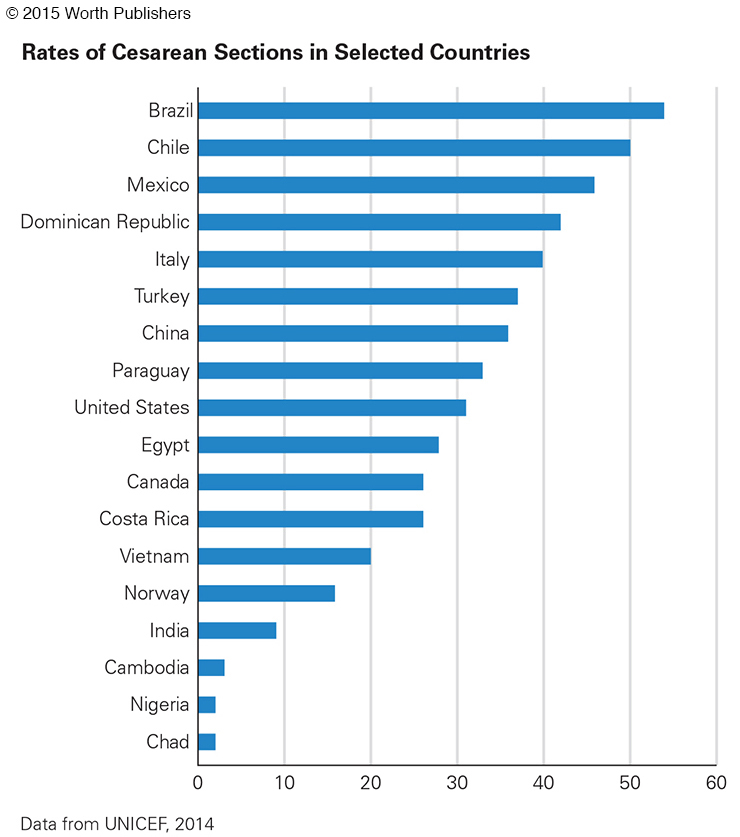
In the United States, the cesarean rate rose between 1996 and 2008 (from 21 percent to 34 percent) and then stabilized. Variation is dramatic from one hospital to another—
Cesareans are usually safe for mother and baby, saving lives when the fetal head is too large for the pelvis. Twins may survive more often with c-
Disadvantages appear later. C-
Less studied is the epidural, an injection in the spine that alleviates pain. Epidurals are often used in hospital births, but they increase the rate of cesarean sections, decrease newborn sucking immediately after birth, and increase rates of other complications—
Another medical intervention is induced labor, when labor is started, speeded, or strengthened with a drug. The rate of induced labor in developed nations has more than doubled since 1990, up to 20 or 25 percent. Sometimes induction is necessary for the health of the mother or the fetus. However, induced labor itself increases complications (Grivell et al., 2012).
Questions of costs and benefits abound. For instance, c-
Complications vary as well. A study of 750,000 births in the United States divided hospitals into three categories—
Most U.S. births now take place in hospital labor rooms with high-
Compared with the United States, planned home births are more common in many other developed nations (2 percent in England, 30 percent in the Netherlands) where midwives are paid by the government. In the Netherlands, special ambulances called flying storks speed mother and newborn to a hospital if needed. Dutch research finds home births better for mothers and no worse for infants than hospital births (de Jonge et al., 2013).
doula
A woman who helps with the birth process. Doulas are trained to offer support, including massage during birth and help with breast-
Many women in the United States and elsewhere have a doula, a person trained to support the laboring woman. Doulas time contractions, use massage, provide encouragement, and do whatever else is helpful. The term originally came from ancient Greece, and doulas have been traditional in Latin America for centuries.
Every comparison study finds that the rate of medical intervention is lower when doulas are part of the birth team. Doulas have proven to be particularly helpful for immigrant, low-
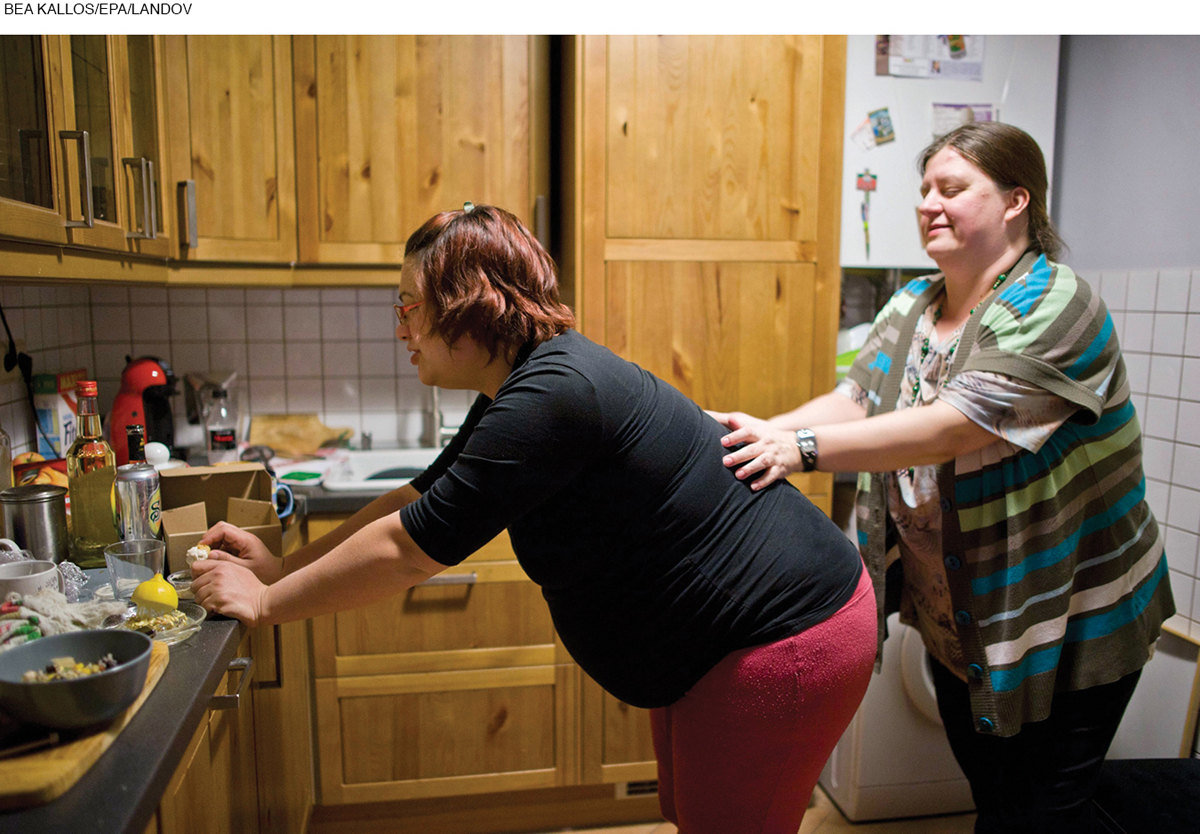
Question 2.9
OBSERVATION QUIZ
What evidence shows that even in Hanoi, technology is part of this birth?
The computer printout on the far right. Monitors during labor track contractions, fetal heart rate, and sometimes more, printing out the record minute by minute so that medical staff can judge whether to speed up labor or birth. In this case, no medical help was required.

The New Family
Video: Newborn Reflexes shows several infants displaying the reflexes discussed in this section.
Humans are social creatures, seeking interaction with their families and their societies. We have already seen how crucial social support is during pregnancy; social interaction may become even more important for newborns.
THE NEWEST FAMILY MEMBER A newborn’s appearance (big hairless head, tiny toes, and so on) stirs the human heart, evident in adults’ brain activity and heart rate. Fathers are often enraptured by their scraggly newborn and protective of the exhausted mother, who may appreciate their husband more than before, for hormonal as well as practical reasons.
Brazelton Neonatal Behavioral Assessment Scale (NBAS)
A test often administered to newborns that measures responsiveness and records 46 behaviors, including 20 reflexes.
Newborns are responsive social creatures in the first hours of life (Zeifman, 2013). They listen, stare, cry, stop crying, and cuddle. In the first day or two, a professional might administer the Brazelton Neonatal Behavioral Assessment Scale (NBAS), which records 46 behaviors, including 20 reflexes. Parents who watch their baby responding in the NBAS are often amazed—
reflex
An unlearned, involuntary action or movement in response to a stimulus. A reflex occurs without conscious thought.
Technically, a reflex is an involuntary response to a particular stimulus. Humans of every age reflexively protect themselves (the eye blink is an example). Reflexes seem automatic. Not quite. The strength and reliability of newborn reflexes varies depending on genes, drugs at birth, and overall health.

Newborns’ senses are also responsive: New babies listen more to voices than to traffic, for instance. Thus, in many ways, newborns connect with the people of their world, who are predisposed to respond (Zeifman, 2013). If the baby performing these actions on the Brazelton NBAS were your own, you would be proud and amazed; that is part of being human.
postpartum depression
The sadness and inadequacy felt by some new mothers in the days and weeks after giving birth.
NEW MOTHERS Many women experience significant physical problems soon after birth, such as healing from a c-
With postpartum depression, baby care (feeding, diapering, bathing) feels very burdensome. The newborn’s cry may not compel the mother to carry and nurse her infant. Instead, the mother may be terrified that she might neglect or abuse her infant.
The first sign that something is amiss may be euphoria after birth. A new mother may be unable to sleep, or to stop talking. After the initial high, severe depression may set in.
Postpartum depression is affected by anesthesia, hormones, pain, financial stress, marital problems, a birth that did not go as planned, surgery, and a baby with feeding or other problems. Successful breast-
Some researchers believe that postpartum depression is a consequence of modern life, because contemporary women consume less omega-
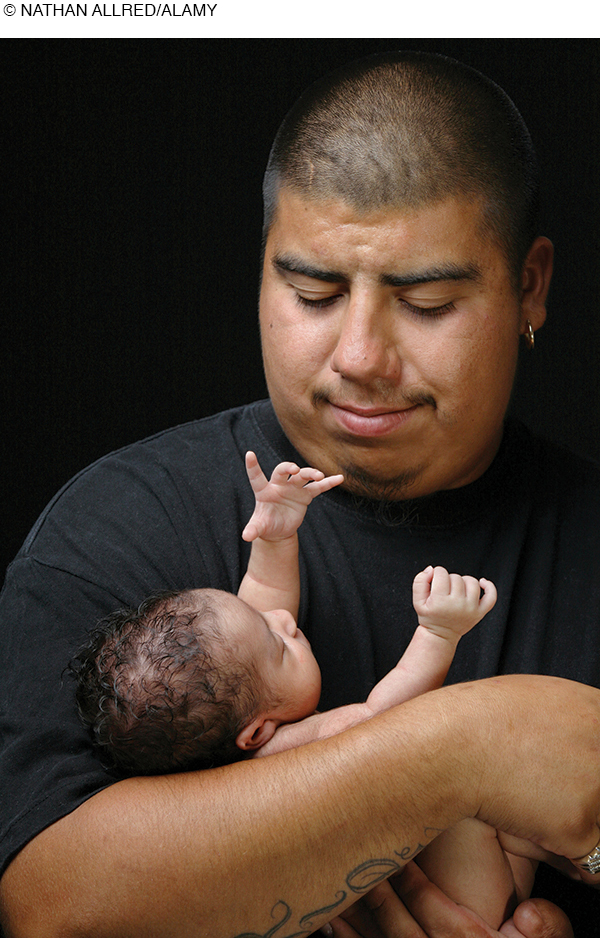
NEW FATHERS At birth, the father’s presence reduces complications. I observed this when my daughter Elissa birthed Asa (now 5, as noted in the opening of this chapter). Asa’s birth took much longer than his younger brother’s; Elissa’s anxiety rose when the doctor and midwife discussed a possible cesarean for “failure to progress” without consulting her. Her husband told her, “All you need to do is relax between contractions and push when a contraction comes. I will do the rest.” She listened. He did. No cesarean.
Whether or not he is present at the birth, the father’s legal acceptance of the birth is important to mother and newborn. A study of all live, single births in Milwaukee from 1993 to 2006 (151,869 babies!) found that complications correlated with several expected variables (e.g., maternal cigarette smoking) and one unexpected one—
Currently, about half of all U.S. women are not married when their baby is born (U.S. Census Bureau, 2014), but fathers are usually listed. When fathers acknowledge their role, birth is better for mother and child.
Fathers may experience pregnancy and birth biologically, not just psychologically. Many fathers experience symptoms, including weight gain and indigestion during pregnancy and pain during labor.
couvade
Symptoms of pregnancy and birth experienced by fathers.
Paternal experiences of pregnancy and birth are called couvade—expected in some cultures such as India, normal in many, and considered pathological in others (M. Sloan, 2009; Ganapathy, 2014). In the United States, couvade is unnoticed and unstudied, but many fathers are intensely involved with their future child (Brennan et al., 2007; Raeburn, 2014). Like new mothers, fathers are vulnerable to depression; other people need to help. Indeed, sometimes the father experiences more problems than the mother (Bradley & Slade, 2011).
WHAT HAVE YOU LEARNED?
Question 2.10
1. What major event occurs to end the germinal period?
About ten days after conception, implantation occurs, in which the developing organism burrows into the tissue that lines the uterus, where it will be nourished. It is here that the formless mass of cells takes shape and becomes a new embryo.
Question 2.11
2. What body parts develop during the embryonic period?
The brain and spinal column, eyes, ears, nose, and mouth start to form, as do the heart, arms, and legs. This is followed by the upper arm, forearm, palms, webbed fingers, legs, knees, feet, and webbed toes.
Question 2.12
3. What crucial developments occur about halfway through the fetal period?
Mid-
Question 2.13
4. What five vital signs does the Apgar scale measure?
Heart rate, respiratory effort, muscle tone, color, and reflexes
Question 2.14
5. What are the advantages and disadvantages of cesarean sections?
Cesareans are usually safe for mother and baby, saving lives when the fetal head is too large for the pelvis. They are advantageous for hospitals and for women who want to plan when to give birth. In terms of disadvantages, C-
Question 2.15
6. In what ways do doulas support women before, during, and after labor?
Doulas time contractions, use massage, provide encouragement, and do whatever else is helpful to women in labor. In the United States, doulas typically help couples decide when to leave home, avoiding long waits between hospital admittance and birth. Laboring mothers and their doulas are often together from early labor to the first breastfeeding of the newborn.
Question 2.16
7. What in the newborn’s appearance and behavior helps with parental bonding?
A newborn’s appearance (big hairless head, tiny toes, and so on) causes new parents to swoon and feel protective over their new baby. Newborns stare, cry, stop crying, and cuddle in their first hours of life, which aids in bonding.
Question 2.17
8. How do fathers experience pregnancy and birth?
Many fathers experience biological symptoms of pregnancy and birth along with their partners. They may experience weight gain and indigestion during pregnancy and pain during labor, indicative of a phenomenon known as couvade.
Question 2.18
9. What are the signs of postpartum depression?
A new mother might seem euphoric after birth—